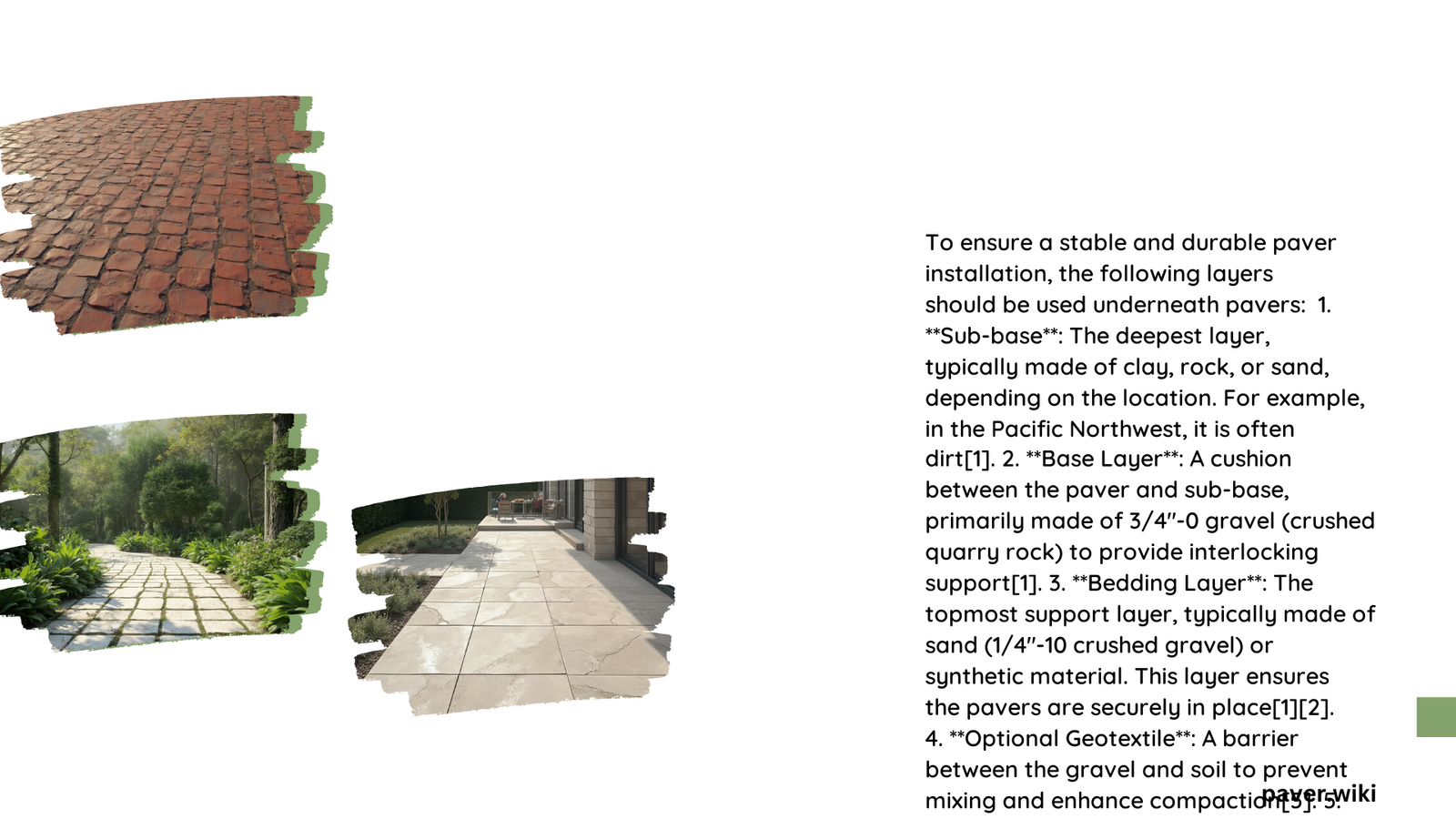When installing pavers, it’s crucial to understand what to put underneath them for optimal stability and drainage. The proper foundation consists of several layers: a gravel base, a sand layer, and often a geotextile fabric. These materials work together to provide a stable, well-draining surface that prevents settling and extends the life of your paver installation. This guide will explore each layer in detail, providing you with the knowledge to create a durable paver surface.
What Materials Are Needed for the Base Layer?
The base layer is the foundation of your paver installation. It typically consists of:
- Gravel or crushed stone
- Geotextile fabric (optional but recommended)
Gravel Base
- Type: Use ¾ inch clean gravel or modified crushed stone
- Depth: 4-6 inches, depending on soil type and application
- Compaction: Use a plate compactor for firm, stable base
Geotextile Fabric
- Purpose: Stabilizes soil and improves drainage
- Installation: Lay directly on soil before adding gravel
- Coverage: Ensure 6-12 inch overlap between sheets
How Deep Should the Gravel Base Be?

The depth of your gravel base depends on several factors:
| Soil Type | Recommended Depth |
|---|---|
| Sandy | 4 inches |
| Clay | 6 inches |
| Heavy Use | 8 inches or more |
Always consult local building codes and manufacturer recommendations for specific depth requirements in your area.
What Type of Sand Should Be Used Under Pavers?
The sand layer, also known as the setting bed, is crucial for creating a smooth surface for the pavers.
Characteristics of Ideal Sand:
- Washed and clean
- Non-plastic
- Meets ASTM C33 Standard Specification for Concrete Aggregate
Sand Layer Specifications:
- Thickness: 1 inch
- Leveling: Use a screed board for even distribution
- Compaction: Light compaction only; heavy compaction occurs after paver placement
How Does Drainage Material Affect Paver Installation?
Proper drainage is essential for the longevity of your paver installation. Here’s how to ensure good drainage:
- Slope: Create a slight slope (about 1/4 inch per foot) away from structures
- Geotextile Fabric: Allows water to pass while stabilizing soil
- Gravel Base: Provides a permeable layer for water to flow through
What Are the Benefits of Using Stabilizing Fabric?
Stabilizing fabric, typically a geotextile material, offers several advantages:
- Prevents soil and gravel from mixing
- Enhances stability of the entire paver system
- Reduces settling and shifting over time
Installation Tips for Stabilizing Fabric:
- Lay fabric directly on compacted soil
- Overlap sheets by 6-12 inches
- Secure with landscape pins or stakes
- Trim excess after installation is complete
How Much Material Is Needed for a 100 Square Foot Paver Installation?
For a standard 100 square foot paver installation, you’ll need approximately:
- Gravel Base: 2.5 to 3.75 tons (for 4-6 inch depth)
- Sand Layer: 0.05 to 0.1 tons (for 1 inch depth)
- Geotextile Fabric: 120 square feet (accounting for overlap)
- Pavers: Varies by style and size
What Are Common Challenges in Paver Installation?
When installing pavers, be aware of these potential issues:
- Improper Compaction: Can lead to settling and unevenness
- Incorrect Slope: May cause drainage problems
- Weed Growth: Use polymeric sand in joints to prevent weeds
- Frost Heave: In cold climates, ensure proper base depth to prevent lifting
How Much Does It Cost to Prepare the Base for Pavers?
The cost of materials for paver base preparation can vary, but here are some estimates:
- Gravel base: $1 to $3 per square foot
- Sand layer: $0.50 to $1.50 per square foot
- Geotextile fabric: $0.25 to $0.50 per square foot
Note that these prices don’t include labor costs, which can significantly impact the total project expense.
By understanding what to put underneath pavers and following these guidelines, you can create a stable, long-lasting paver installation that enhances your outdoor space for years to come.
References:
1. Paver Installation Process | Belgard
2. paver-guide-specifications.pdf – Willow Creek Paving Stones
3. Paver Installation: Materials, Tools and Process – Plant Design Group
